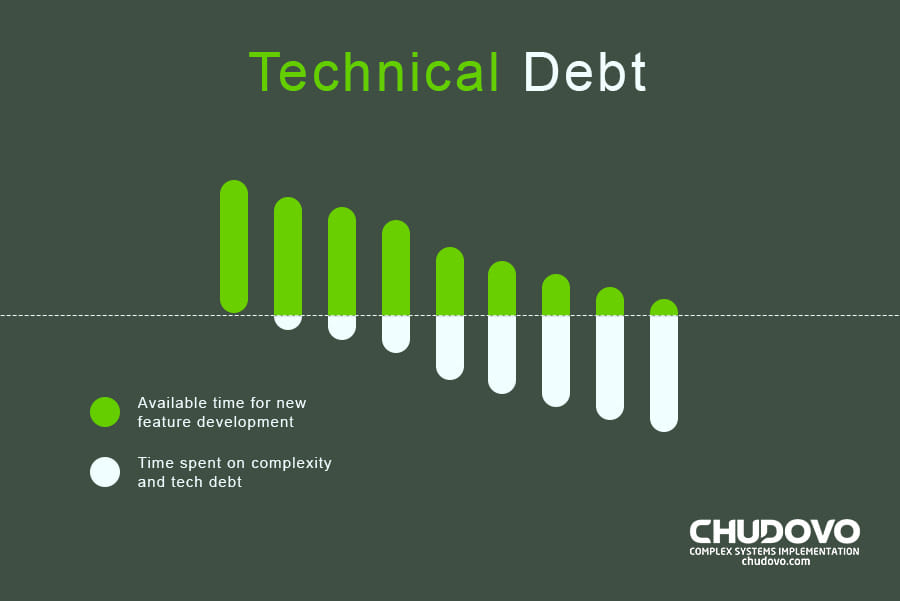Decoding the Complexities: An In-depth Exploration of Technical Debt
Within the advancing, fast-paced universe of software development, technical debt consistently emerges as a highly debated topic. Technical debt is one of the most pressing issues in software engineering today, but it’s a concept that can be difficult to grasp.
It can be confusing to understand why certain decisions have been made and what the repercussions may be. However, simply put, it is the long-term price one pays when opting for quick-fix solutions under time pressures or looming deadlines. Every decision to cut corners, prioritize speed over quality, or use a temporary fix can add to the “debt.”
The complexity and multi-dimensionality of technical debt, its causative factors, its consequences, and the best strategies for managing it make it a fascinating topic of debate in the field. In this article, we’ll take an in-depth look at technical debt, exploring the intricacies of its many forms, how it affects your projects, and discussing how best to manage it effectively.
Table of Content
- What is Technical Debt?
- Main Causes of the Technical Debt
- The Impact of Technical Debt on Projects
- Strategies to Prevent the Accumulation of Technical Debt
- Tackling Existing Technical Debt: Practical Solutions
- Metrics for Quantifying Technical Debt
- The Future of Technical Debt Management: Trends and Predictions
- Conclusion
- Frequently Asked Questions (FAQs)

What Is Technical Debt?
Technical debt in software development is a phenomenon commonly used in the software development industry that refers to the consequences of choosing the expedient and easy solution over the correct but longer approach. This symbolic “debt” can pile up over time and cause significant issues for development teams. Technical debt can take many forms, such as bugs, architecture flaws, and software glitches.
At its core, technical debt is the aftermath of developers prioritizing short-term success over long-term gains. For instance, a developer might resort to shortcuts when coding. From avoiding comprehensive testing to using outdated libraries to meet project deadlines, these decisions can cause immediate improvements. Still, they can create long-term problems that can increase project costs and lead to delays.
Much like financial debt, technical debt is not inherently harmful. In fact, it can be a strategic move, letting teams expedite a product or software launch. The caveat, however, is the increased cost of this debt accrues over time if not repaid or managed. Just like monetary debt left unchecked accrues interest, so too does technical debt increase the costs of future software development tasks, owing to the need for code refactoring and the potential disruption it brings to the system.
So, the trick lies in tracking and management of this debt. Successful tech giants such as Amazon have made the most of the power of technical debt remediation by using a blend of automated tools, dedicated team efforts, and custom solutions.
Main Causes of the Technical Debt
Now that we know what technical debt is, let’s dig deeper to know the different factors that cause and source technical debts. It is important as technical debts can result in higher costs and reduced efficiency in the long run. So, understanding the causes and sources of technical debt is crucial in effectively managing and mitigating it.
Rush to meet the deadline
The time pressure to meet the deadline is one of the most fundamental causes of technical debt. To meet the expectation of today’s face-paced market, developers often embrace quick but less optimal solutions so they can meet the deadline. This process of cutting corners with the mindset to ‘expedite now, refine later’ plants the seed of technical debt that accumulates over time.
While these decisions may pave the way for an on-time launch, the common reflex to prioritize speed over perfection demands technical debt remediation. This can be in code refactoring, architectural changes, or even complete rewrites.
Financial and manpower constraints
Another cause of technical debt is a limited budget and a lack of skilled manpower, which leads to developers making trade-offs that lead to debts. Having financial constraint means the team is unable to access up-to-date tools and technologies to create optimized code and are relying on outdated technologies. In the light of keeping the budget low, the force might resort to prioritizing visible features over the under-the-hood quality, adding to the technical debt pile.
The resource constraint also means having a shortage of skilled developers who lack the expertise and experience to curate high-quality code. This factor is more prevalent in complex projects where less experienced developers might miss nuances of software architecture, efficient algorithms or advanced testing strategies.
Changing requirements of the business
The third source of technical debt is the ever-changing requirements of business and ever-evolving technologies. This is best explained via an e-commerce website designed to cater to fewer daily users. However, with an increase in the business and users per day, the initial code may not withstand the scalability.
The solution for this would be significant refactoring that required massive time, resources and expertise, leading to the accumulation of technical debt. It should also be noted that if these changes are frequent, the developer might have to prioritize speed over perfection, resulting in shortcuts and quick fixes that leave a trail of technical debt.
Poor documentation
While you might wonder if poor documentation might not lead to significant technical debt, its absence can send you spiralling into the red. The rigorous maintenance of the documentation, such as missing comments in code, outdated system diagrams, neglected user manuals, and lack of documentation, can pile the technical debt.
This is mainly because developers miss the guidelines to decode the mysteries of code sequence and system designs. On the other hand, if there is a well-documented codebase, developers can understand the different software components work together, identify potential issues, and resolve them in the beginning itself. So, having good maintenance of the documents helps in mitigating technical debts over some time.

The Impact of Technical Debt on Project
Several causes of technical debt have an impact on the project. Starting right from the development phase to the maintenance of software, technical debt can pile up if left unchecked. Let’s look at some of the impacts the technical debt has on the projects.
Slow progress but increased cost
Once the technical debt has accumulated, the code base becomes more complex, making it difficult for the developers to make edits and incorporate new features. This means that more time would be spent on completing the project, making the development slower. At the same time, working on projects with technical debts means the developers are not able to work on the new features. This means the operational costs increase and hampers the team’s overall productivity.
Compromised quality
High technical debt often leads to decreased software quality, which could have significant, far-reaching consequences. Software with accumulated technical debts would have bugs and performance issues that cause system crashes, slow response, and security vulnerabilities.
Every single of these leads to compromised quality that results in customer dissatisfaction. An example of this would be an e-commerce site. If the site is facing the consequences of technical debts, it will impact the sales and revenue of the business. Customers might just leave the site without purchasing the product due to slow response time or encountering issues, creating a bad customer experience.
Innovation and growth hindrances
The unseen opportunity cost of the technical debts is that the existing resources are utilized in fixing the issues as the technical debt remediation. From correcting bugs and issues to restructuring the flawed design, the resources are spent firefighting the technical debts. This diverts the attention from the growth and innovation of the company.
The challenge of managing technical debt also creates a roadblock to adopting new technologies or integrating disruptive innovations. In a world of rapid and continuous tech advancement, outdated software can quickly become a liability. Newer technologies offer better features and improved efficiency and can be pivotal in gaining a competitive edge. However, a codebase cluttered with technical debt can be unwieldy and inflexible, making it difficult to incorporate these new advancements seamlessly.
Team morale
The persistent struggle with a codebase saturated in technical debt can drain the team’s morale. It’s a less visible yet equally critical dimension of the debt’s fallout. When developers are constantly wrestling with complex, convoluted code, it can stifle their capacity for creativity, problem-solving, and general job satisfaction.
Coding is not merely a job for most developers; it’s an art, a passion. However, when they find themselves mired in the maze of technical debt, the joy of creating innovative software solutions can get overshadowed by the relentless cycle of debugging and remediation.

Strategies to Prevent the Accumulation of Technical Debt
Addressing technical debt is not a one-time fix but a persistent initiative that needs to begin even before scripting the initial line of code. Keeping technical debt at bay demands a synthesis of astute planning, strategic vision, and streamlined management techniques. Let’s delve into how you can proactively curtail the accumulation of technical debt.
Proactive approaches to minimize technical debt
The best way to handle technical debt is to avoid its accumulation in the first place. Taking a proactive approach to software development can keep technical debt in check:
Prioritizing Code Quality: Prioritize writing clean, efficient, and scalable code right from the beginning of the project. High-quality code is less likely to require extensive debugging or remodelling down the line, helping to prevent the accumulation of technical debt.
Continuous Refactoring: Refactoring involves making small improvements to the codebase without altering its external behaviour. By routinely refactoring your code, you can ensure that it remains clean, efficient, and manageable, significantly reducing the risk of technical debt.
Use of Automated Testing: Automated testing tools can help catch bugs and performance issues early in the development cycle. It can ensure your code remains error-free and efficient, minimizing technical debt risk.
Documentation: Keeping up-to-date, comprehensive documentation is vital. This ensures every team member understands the code, how it works, and why specific decisions were made. It helps prevent the accumulation of unintentional technical debt due to miscommunication or misunderstanding.
The role of agile methodologies in debt prevention
Agile methodologies, emphasizing iterative development, constant feedback, and continuous improvement, can be highly effective in preventing technical debt.
- Iterative Development
Agile promotes software development in small, manageable chunks. This allows developers to focus on code quality and swiftly address any potential issues that could contribute to technical debt.
- Regular Reviews and Retrospectives
Agile methodologies encourage regular code reviews and retrospectives. These allow the team to identify areas of potential debt and plan for its remediation.
- Prioritizing Debt Management in the Backlog
In an agile project, the product backlog is a dynamic resource that guides the team’s work. By including technical debt items in the backlog, the team can prioritize their resolution alongside new feature development.
Tackling Existing Technical Debt: Practical Solutions
Addressing existing technical debt can feel like navigating through a tangled forest. However, armed with effective strategies, it is possible to detangle and pave a path towards more maintainable, efficient software development practices. Let’s break down practical solutions and long-term strategies for technical debt remediation.
Steps to manage and reduce technical debt
- Debt Discovery
The first step is identifying and quantifying your technical debt. Utilize code review tools, automated testing, and other code analysis techniques to map out the scope and severity of your technical debt.
- Prioritization
Once you have a debt list, prioritize remediation efforts based on the potential risks and repercussions. Consider factors like the likelihood of a bug surfacing, the severity of its impact, and the amount of time required for the fix.
- Dedicated Remediation Time
Schedule regular, dedicated time for your development team to focus on debt reduction. This ‘clean-up’ time can be included in the regular sprint cycles or planned as separate technical debt sprints.
- Prevent Further Accumulation
While addressing existing debt, it’s essential to implement measures to prevent new debt from piling up. This can involve stricter code review processes, more extensive automated testing, or tighter adherence to coding standards.
Implementing a long-term strategy for debt repayment
Cultural Shift
Encourage a mindset within your team where high-quality code is valued over quick and dirty fixes. This requires a cultural shift where technical debt is acknowledged and treated as a real, tangible risk.
Ongoing Measurement
- Make technical debt tracking an ongoing process.
- Regularly measure and monitor your debt to keep it from spiralling out of control.
- Use tools and technical debt metrics to help with this tracking.
Long-term Planning
Incorporate technical debt considerations into your project planning and estimation processes. Allocate resources for debt repayment as you would any other feature or bug fix.
Continuous Learning
Adopt a culture of constant learning and improvement. Encourage your team to stay updated with innovation, new technologies, and best practices in software development. This can help you adopt practices that minimize the accumulation of new debt.
Metrics for Quantifying Technical Debt
Quantifying technical debt is as crucial as identifying its existence. For effective management, metrics that provide a tangible measure of technical debt are indispensable. This segment explores some key yardsticks for measuring technical debt, along with the importance of conducting regular audits for assessment.
The complexity of the codebase often serves as an indicator of high technical debt. Metrics like cyclomatic complexity provide insight, measuring the number of linearly independent paths through a program’s source code. Similarly, the code coverage metric can determine the extent of code covered by your testing suites. A low percentage here might signal under-tested code and potential technical debt.
Another critical aspect to consider is the frequency of changes to the codebase, which is measured by the code churn metric. High code churn could point towards recurring issues and problematic areas in the code, thus signifying technical debt. The duration from when the code is written to its deployment, known as the time to market, can also suggest the presence of technical debt. An expanding timeline might indicate that debt is slowing down the development process. Lastly, an increase in the number of bugs being discovered can often correlate with a rise in technical debt.
Alongside these metrics, consistent monitoring through regular audits is vital to managing technical debt effectively. Audits systematically evaluate the codebase, highlighting potential debt accumulation areas. By acting as a preventative measure, they curb small debts from snowballing into larger issues.
Moreover, they inculcate a culture of continuous improvement within the development team. Regular audits stress the importance of clean, maintainable code and promote adherence to best practices among developers, thus reducing the likelihood of future debt accumulation.

Certified engineers
Convenient rates
Fast start
Profitable conditions
Agreement with
EU company
English and German
speaking engineers
The Future of Technical Debt Management: Trends and Predictions
As we venture further into the digital age, technical debt management is becoming a central concern. Innovative approaches, technologies, and tools are emerging to help teams effectively handle this aspect of software development. Let’s delve into some of the trends and predictions that could shape the future of technical debt management:
Harnessing AI and automation for debt management
As artificial intelligence (AI) and automation continue to disrupt several industries, their impact on technical debt management is becoming increasingly apparent. Machine learning algorithms can potentially be used to analyze codebases, identifying patterns and anomalies that could indicate areas of high technical debt.
The automated approach can help provide a comprehensive view of the debt landscape faster than manual analysis. Similarly, AI can assist in prioritizing the technical debt remediation process by forecasting the potential impact of various debt components. AI can help us understand which elements of debt would cause the most significant disruption if left unaddressed, allowing teams to tackle those issues first.
Predictive analytics: the future of technical debt assessment
Predictive models could forecast where and when new technical debt might arise by analyzing various factors like code complexity, the history of project development, team dynamics, and even external aspects such as market trends. This would allow teams to take preventive measures, thereby minimizing the impact of debt on the project.
However, as with any predictive model, it’s crucial to remember that these are based on probabilities, not certainties. Therefore, while these tools can provide valuable insights and guidance, they should be used with human judgement and expertise.
Conclusion
Understanding and adeptly managing technical debt forms an integral part of software development processes and paves the way for sustainable innovation and long-term success. Thus, as we forge ahead in the software industry, handling technical debt with skill and precision will be a crucial determinant of our progress.
Frequently Asked Questions (FAQs)
Is it possible to eliminate technical debt?
While it would be ideal to have no technical debt, it’s virtually impossible in practice. Technical debt is a natural byproduct of software development, particularly in agile, fast-paced environments. What’s crucial is not the complete elimination of technical debt but the effective management of it. Prioritizing, tracking, and regularly addressing the most critical areas of debt can help keep it under control.
How do you measure technical debt?
Code metrics like code duplication, cyclomatic complexity, depth of inheritance, class coupling, and lines of code can indicate technical debt. Tools like SonarQube can help automate this measurement process. Moreover, considering factors like the amount of time spent on maintenance tasks, frequency of production issues, or the speed of feature delivery can also provide valuable insights into the levels of technical debt.
How does technical debt impact team morale?
High levels of technical debt can negatively affect team morale. Developers working on a project with technical debt might find their tasks more challenging, frustrating, or tedious. It limits their ability to introduce new features or make changes, reducing their productivity and satisfaction levels. Ultimately, it can lead to higher turnover rates as developers seek more fulfilling work elsewhere.
If you need proven software developers, contact us now!




